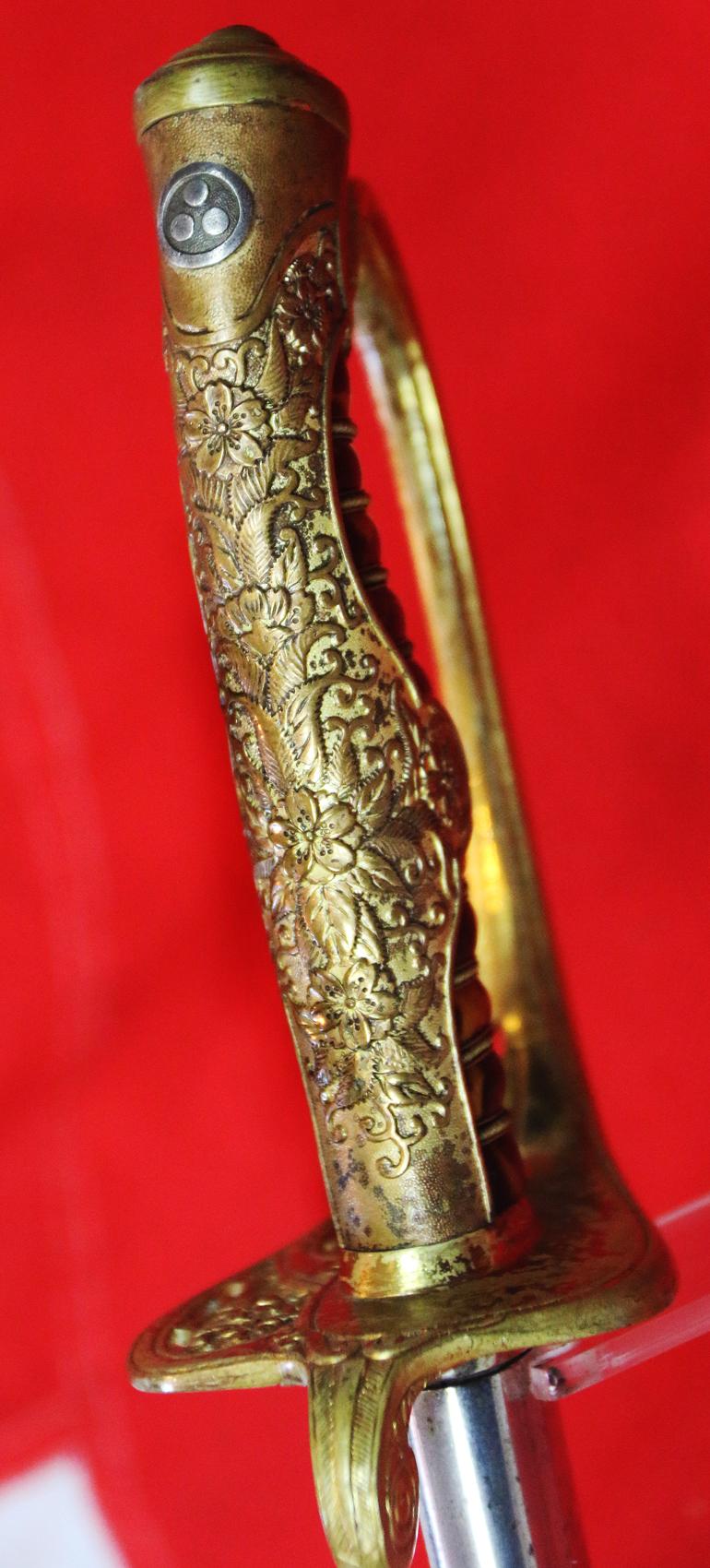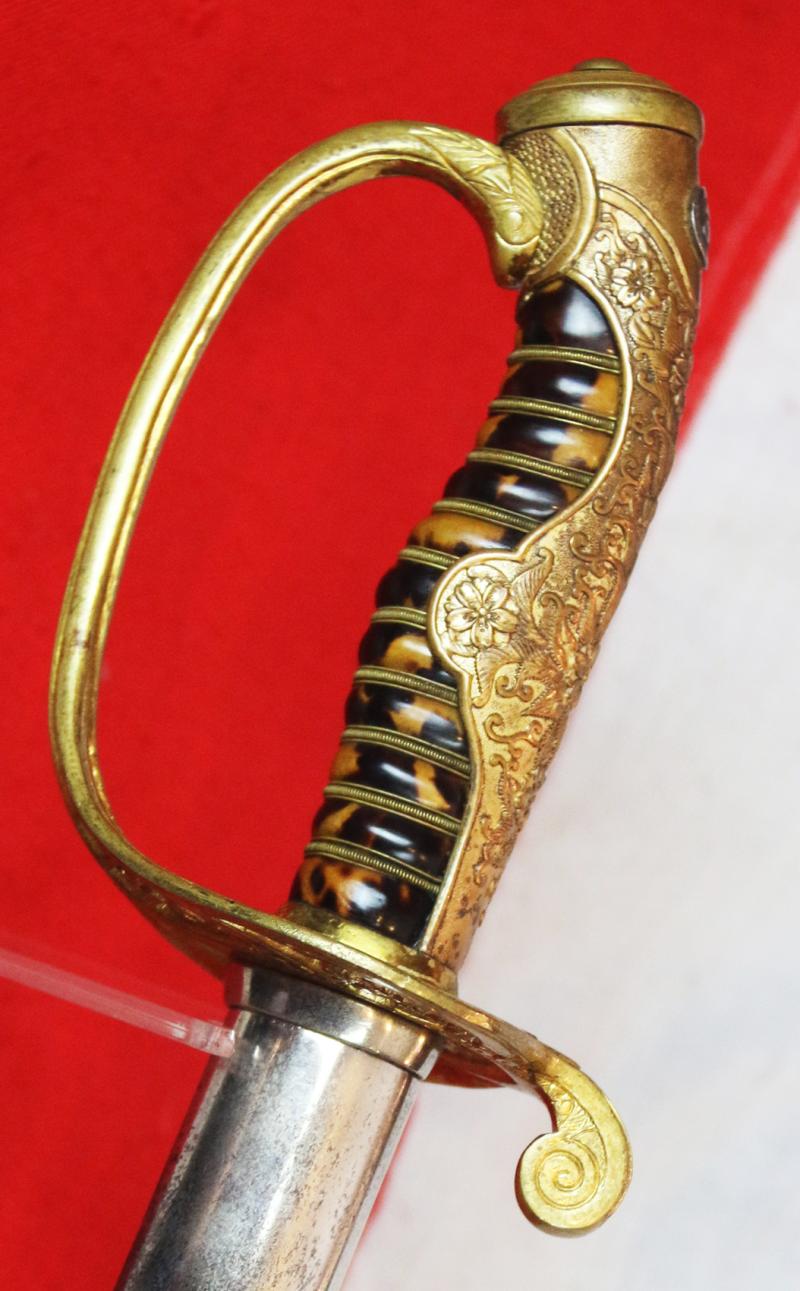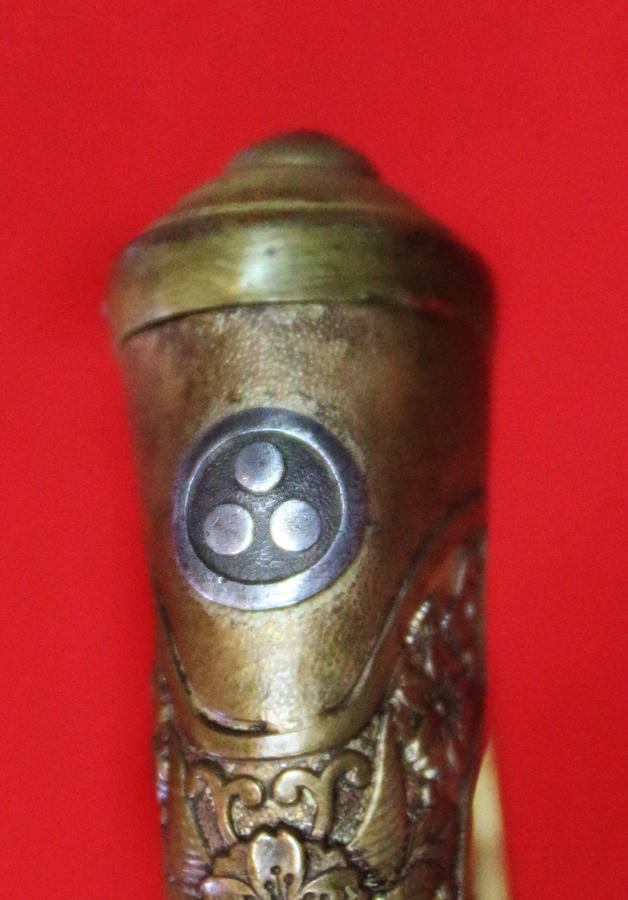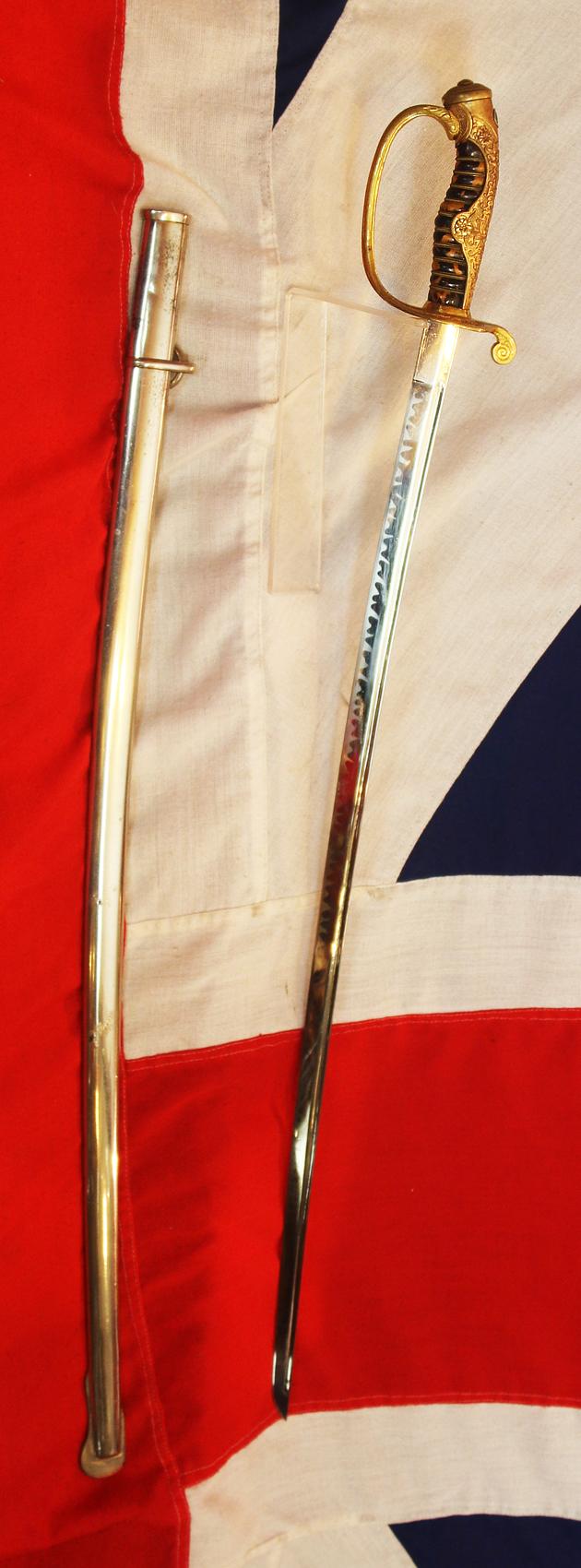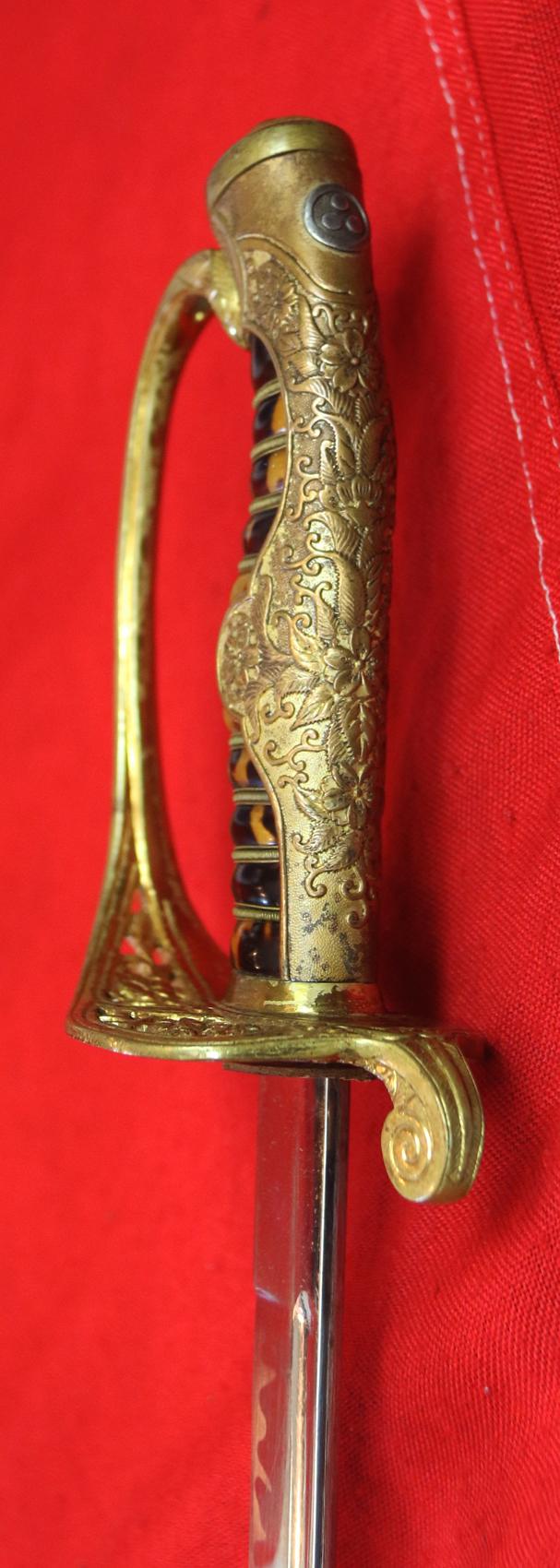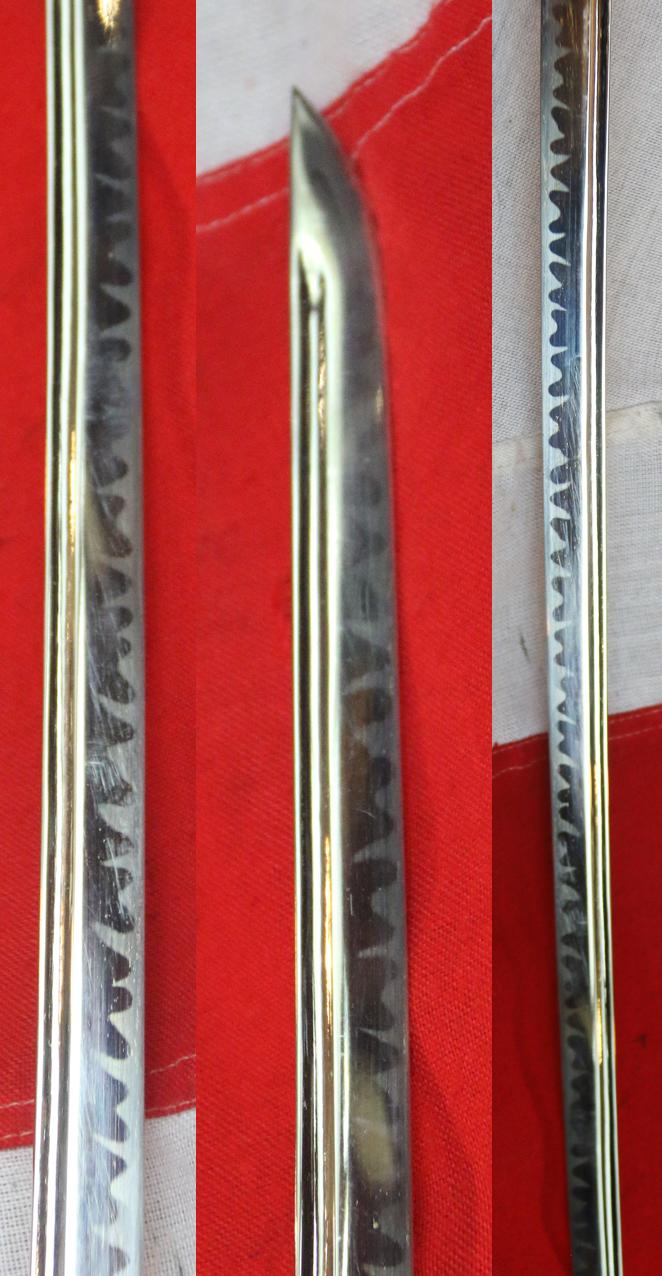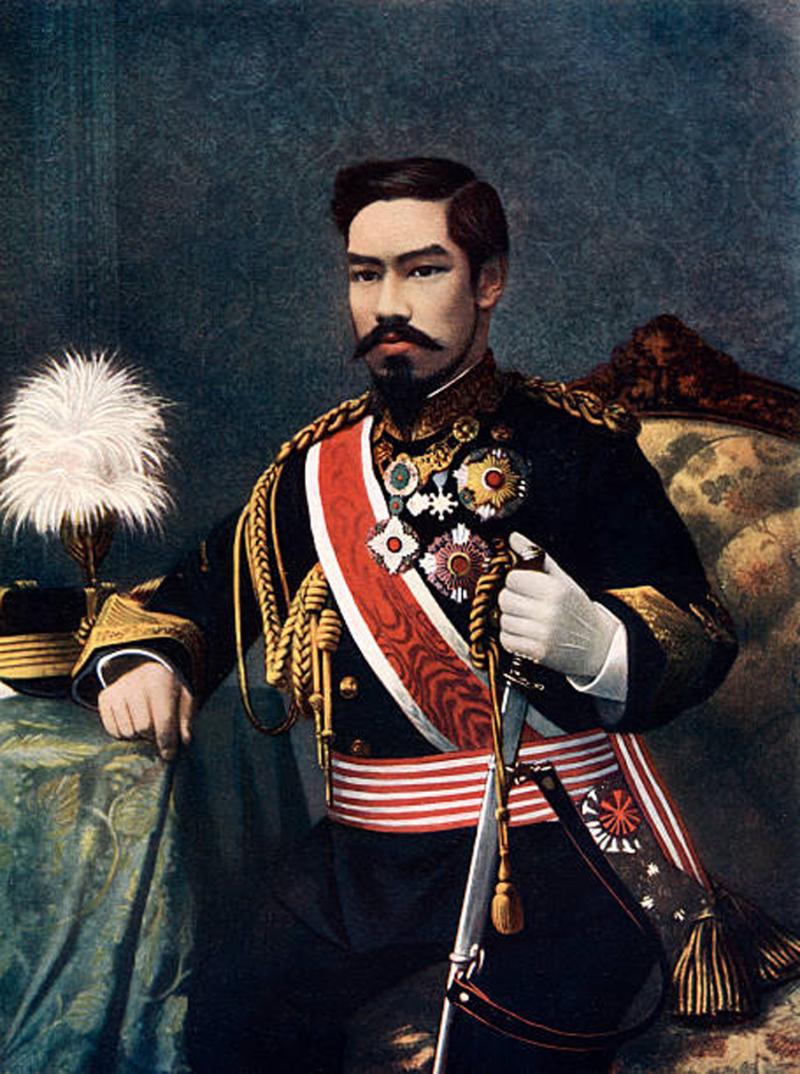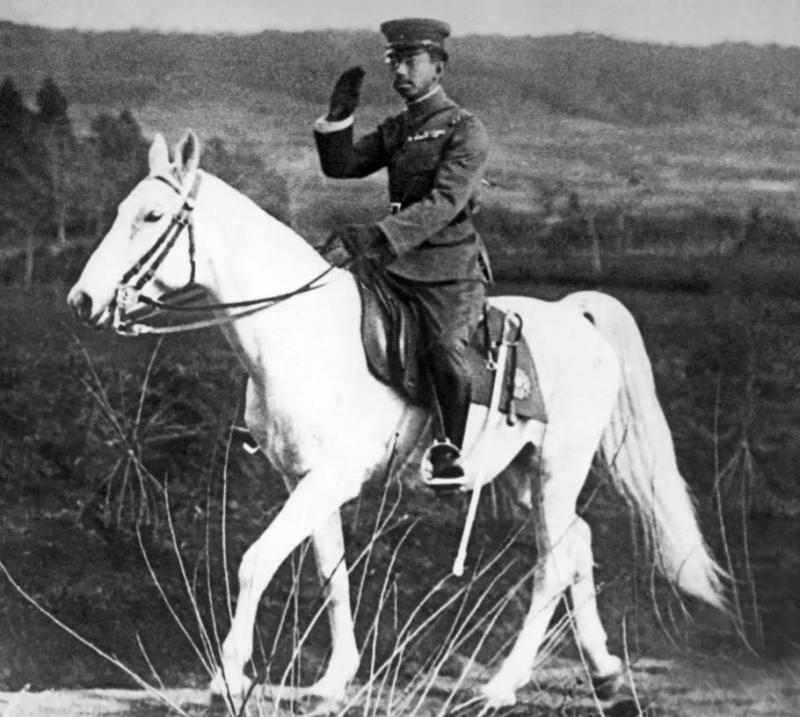A Superb 1875 pattern Japanese General's Dress Parade Sword of an Imperial Japanese Army General of the Matsuura Clan. Lt General Junrokurō Matsuura Commander of the 106th Infantry Division in China
The hilt has all its original gilt and the general's pattern fully relief decorated back strap surmounted by the silver clan mon of the Matsuura clan, its original multi wire bound generals pattern hawksbill turtle grip, is superbly intact, and the blade has an unusual crab-claw pattern, etched, full length hamon to the blade, in very good polish, with just slight overall service abrasive wear. The nickel plated scabbard in very nice condition for age, with a single very small dent and a few plate surface blemishes. It has a single mount ring
The 1875 pattern General's parade sword had one of the longest service lives of all the Japanese military swords. Worn from the late 1870's right into the end of WW2. Emperor Meiji carried the 1875 General's parade sword as did Emperor Hirohito, the Showa Emperor and last living god of Japan, carried his 1875 General's sabre when on horseback, which of course may well have been his ancestors sword Emperor Meiji {see in the gallery Emperor Hiro Hito with the sword carried on horseback with one scabbard ring, and Emperor Meiji wearing the sword while seated, using two scabbard rings.}
Due research revealed the most probably owner of the sword due to the only Matsuura Clan General in military service in this period.
Junrokurō Matsuura {also spelt Matsura}, was a lieutenant general in the Imperial Japanese Army in the Second Sino-Japanese War, and WW2. In Japanese terms the second world war started earlier than most, from the invasion of China. For America WW2 ran from 1941 to 1945, as did WW2 for Russia, and for Britain and Europe in started in two years earlier in 1939.
Matsuura was Head of the Personnel Bureau of the Ministry of War until 1935.
Then Commandant of Toyama Army Infantry School in 1935, and that same year became the commander of IJA 10th Division until 1937 when he went into the reserves and retired
However, in 1938, General Matsuura was recalled to active service, and appointed the commanding officer of the IJA 106th Division in China during the Second Sino-Japanese War, in command of an excess of 10,000 officers and men. His division was involved the Wuchang-Hankou Campaign especially the Battle of Wanjialing.
The report written by Lieutenant General Matsuura, the head of the 106th Division of the Japanese Army, to the Emperor of Japan. In the report, he wrote: "In the Wuhan battle , 3321 people died in battle, 12 people above the battalion commander, 4085 were hospitalized for war injuries, and 7969 were hospitalized for common diseases. Most of them died in Wanjialing."
He returned to Japan in early 1939, with his division reduced to just around 1,000 survivors of the battle and went into retirement once more.
The sword is in superb condition, with all its original gilt to the hilt, with the general's pattern back strap surmounted with the silver Matsuura clan mon. The hilt grip is the general's pattern hawksbill turtle shell, with original multi wire binding. The blade has a crabclaw pattern etched hamon, a single hi and in in full polish with just slight wear. Nickel plated steel scabbard with single ring.
1875 pat generals sword of the Matsura {also spelt Matsuura}
The Matsura family of Hirado, in present-day Nagasaki Prefecture, has a long and storied 800-year history. The clan’s origins are quite colourful—they were involved in trading with Korea and China, smuggling and even piracy. During the epic war between the Taira (Heike) and Minamoto (Genji) at the end of the Heian period, the Matsura sided with the Heike and provided men and boats for the climactic battle of Dannoura, which ended in a complete victory for the Minamoto and paved the way for their leader, Yoritomo, to establish the Kamakura Shogunate, beginning the era of warrior rule of Japan.
During the Kamakura period, the Matsura, through there trading and smuggling network along the vital Chinese ports and trade paths, helped keep the Shogunate informed of Kublai Khan’s invasion plans for Japan in 1274 and 1281 and once again supplied men and material to fight the Mongol invaders. Later on, in the 1500s, as Japan fell deeper into the chaos of civil war, the Matsura gradually increased their powerbase and became a hub of international trade with the Portuguese, Dutch and English, amassing an incredible amount of wealth in this little corner of Kyushu.
The Matsura allied themselves with Toyotomi Hideyoshi when he invaded Kyushu as part of his campaign to unify Japan. In return for their loyalty, Hideyoshi confirmed Matsura Shigenobu as daimyo (feudal lord) over Hirado, a holding valued at an annual income of 63,200 koku (1 koku = amount of rice needed to feed one person for a year). This income was handsomely complimented the amount of money the Matsura were hauling in from legitimate foreign trade as well as the old smuggling and piracy connections (direct involvement in piracy seems to have faded by the early 1600s). As a loyal vassal to Hideyoshi, Shigenobu led a large contingent of his samurai into Korea as a part of Japan’s failed invasion of Korea from 1591-1598. Upon the end of the war, the Matsura built Hinotake Castle as the clan’s main residence. However, the extensiveness of the Castle’s defences, combined with the clan’s neutrality during the clash between the pro-Toyotomi and Tokugawa forces at the battle of Sekigahara brought the clan under the suspicion of the Tokugawa as they consolidated power under their new shogunate. Knowing the clan had much to lose in terms of trade grants as well as its fief, Shigenobu took the dramatic step of setting Hinotake Castle on fire to show the Tokugawa that he was defenceless and at their mercy as a loyal retainer.
Every single item from The Lanes Armoury is accompanied by our unique Certificate of Authenticity. Part of our continued dedication to maintain the standards forged by us over the past 100 years of our family’s trading, as Britain’s oldest established, and favourite, armoury and gallery
Code: 24983


